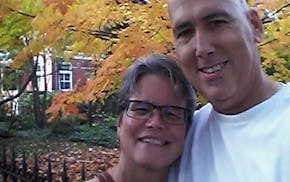We found the first dead body at the building's "drop line" just before dawn on a foggy city morning.
The yellow-rumped warbler had smacked the glass wall of the Hennepin County Government Center and dropped to the ground next to the revolving doors.
The city was just starting to stir, but Joanna Eckles had already started the route around downtown Minneapolis with volunteer Mike Biermaier to find and log the number of dead birds that had run into buildings or skyways.
Eckles, an ornithologist for Audubon Minnesota, oversees teams of trackers who tally the bird deaths in the city during spring and fall migrations.
The group is among the bird lovers currently trying to convince the Minnesota Vikings to install a patterned glass wall on the stadium that would deter birds from running into it. Some have called the design of the stadium, with soaring glass walls, a "bird death trap."
Eckles crouched down and scooped the small bird into her palm.
"Wow, this one is still warm," she said.
Eckels and Biermaier have honed their dead-bird spotting skills, detecting the tiny cadavers that most people scrambling to their jobs miss. Most pedestrians are so oblivious that Biermaier has seen them step on birds that he had bent down to retrieve.
Each bird is tagged with the date, time, location and species. Volunteers put the birds into tiny plastic sandwich bags, then put them in a freezer inside a downtown building.
The data can help Audubon Minnesota detect migration patterns and anomalies, and identify particularly dangerous buildings and skyways.
"It's a tiny survey, by no means comprehensive," said Eckles.
Lights and glass are a bird's enemies, particularly where you can see through a structure. When the group finds a large number of birds outside a particular building, Audubon can alert the building's management and perhaps persuade them to install mitigation devices, such as patterns in the glass, or even shades, that lower the death count.
Sometimes maintenance workers who find dead birds place them in planters so the bird trackers can find them, but many more never make the count because they wind up in a trash can.
Eckles, who has been bird-watching since she was 8 years old, said it is hard to guess how many migrating birds die from hitting man-made features each season. A typical hourlong walk can turn up no birds, or 20. It depends on wind direction, cloud ceiling and precipitation.
Eckles has an uncanny eye, and ear, for birds. She paused in the small park outside the government center.
"You can hear all the white throats in the trees," she said. "They are all around us."
"See this little guy?" said Eckles. "Yellow throat. He shouldn't be down here. He's a marsh bird."
Biermaier pointed down Third Avenue. "Killer skyway down there."
But first we would zigzag through downtown for an hour, scanning the creases along buildings
While the Vikings stadium has drawn all the attention, migrating birds being drawn to downtowns is a broader issue. A few years ago, forums on bird migration issues were sparsely attended at city planning and architecture conventions; now they are common.
"This is a problem we know about and can do something about," said Eckles.
The Vikings can certainly play a huge role, if management changes its attitude. Making bird-friendly designs during construction is much cheaper than fixing it later.
"It's a massive building" near parkland and the river, "and studies show collisions go up exponentially with the amount of glass and light," said Eckles.
The glass currently being planned has 30 percent reflectivity, much higher than the 8 to 12 percent recommended for bird safety.
As early as December 2012, the Minnesota Department of Natural Resources urged the stadium to incorporate bird-safe design. The Minneapolis City Council has recommended that the publicly funded stadium adopt Audubon's suggestions, which would cost a paltry $1 million on the $1 billion building.
"We don't often have this much opportunity to build something that can have a huge impact on bird migration," Eckles said.
We found the second body under the so-called "killer skyway" that crosses Third Avenue. The time of death was duly recorded as 8 a.m. He was a white-throated sparrow.
Eckles keen eye caught something moving in the grass: another white throat that had apparently hit the glass and seemed stunned.
Eckles quickly moved in and gently scooped it up with two fingers as it cheeped loudly.
"It's OK, kid, we're going to help you out," Eckles said. "It's your lucky day."
She got a paper sack out and some toilet paper and placed the bird inside the bag with the paper, a tiny haven for a bird that had come from Canada, on its way to Southern states.
Eckles drove the bird down to the Mississippi, away from the tall buildings. She removed the bird and handed it to me. It was soft and warm, its tiny heart pounding in my hand.
I let the bird go and it flew a few shaky feet. Then it flittered further away as it got stronger.
"See ya, dude," said Eckles. "You've got a lot more cities to get through."
jtevlin@startribune.com • 612-673-1702. Follow Jon on Twitter: @jontevlin

Tevlin: 'Against all odds, I survived a career in journalism'

Tevlin: Grateful Frogtown couple fight their way back from fire and illness



